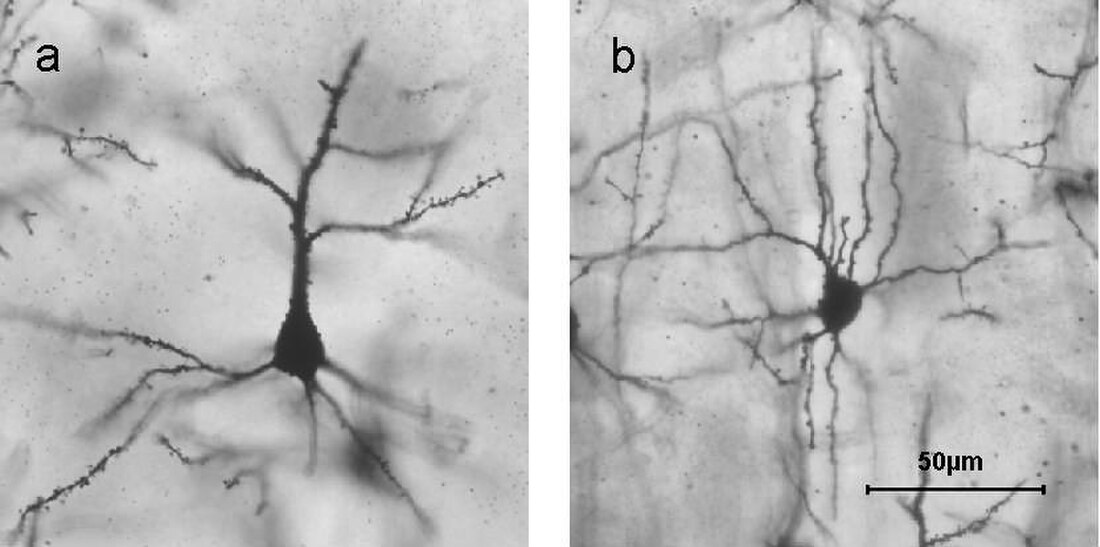Top Qs
Timeline
Chat
Perspective
Stellate cell
Star-shaped neurons in the central nervous system From Wikipedia, the free encyclopedia
Remove ads
Stellate cells are neurons in the central nervous system, named for their star-like shape formed by dendritic processes radiating from the cell body. These cells play significant roles in various brain functions, including inhibition in the cerebellum and excitation in the cortex, and are involved in synaptic plasticity and neurovascular coupling.
This article may incorporate text from a large language model. (November 2025) |
Remove ads
Morphology
Stellate cells are characterized by their star-shaped dendritic trees. Dendrites can vary between neurons, with stellate cells being either spiny or aspinous. In contrast, pyramidal cells, which are also found in the cerebral cortex, are always spiny and pyramid-shaped. The classification of neurons often depends on the presence or absence of dendritic spines: those with spines are classified as spiny, while those without are classified as aspinous.
Remove ads
Types and locations
Summarize
Perspective
Cerebellar
Many stellate cells are GABAergic and are located in the molecular layer of the cerebellum.[1] Most common stellate cells are the inhibitory interneurons found within the upper half of the molecular layer in the cerebellum. These cells synapse onto the dendritic trees of Purkinje cells and send inhibitory signals.[2] Stellate cells are derived from dividing progenitor cells in the white matter of the postnatal cerebellum.
Cortical
Stellate neurons are also found in the cortex. Cortical spiny stellate cells are located in layer IVC of the primary visual cortex,[3] and in the somatosensory barrel cortex of mice and rats, glutamatergic (excitatory) spiny stellate cells are organized in layer 4 of the barrel cortex.[4] These cells receive excitatory synaptic fibers from the thalamus and process feed-forward excitation to layers 2/3 of the primary visual cortex to pyramidal cells. Cortical spiny stellate cells exhibit a 'regular' firing pattern.
Other locations
GABAergic aspinous stellate cells are also found in the somatosensory cortex. These cells can be immunohistochemically labeled with glutamic acid decarboxylase (GAD) due to their GABAergic activity, and they occasionally colocalize with neuropeptides.[5]
Remove ads
Development
Stellate and basket cells originate from the cerebellar ventricular zone (CVZ) along with Purkinje cells and Bergmann glia.[6]: 283 [7] These cells follow a similar pathway during migration, starting in the deep layer of the white matter, moving through the internal granular layer (IGL) and the Purkinje cell layer (PCL) until reaching the molecular layer.[6]: 284 In the molecular layer, stellate cells change orientation and positioning until they reach their final placement, guided by Bergmann glial cells.[8]
Function
Stellate cells receive Excitatory Post Synaptic Potentials (EPSCs) from parallel fibers. The characteristics of these EPSCs depend on the pattern and frequency of presynaptic activity, influencing the extent and duration of inhibition within the cerebellar cortex.[9] Synapses between parallel fibers and stellate cells exhibit plasticity, allowing for long-term changes in synaptic efficacy. This synaptic plasticity can occur at both parallel fiber-stellate cell synapses and parallel fiber-Purkinje cell synapses, suggesting a role in cerebellar motor learning.[10]
Neurovascular Coupling
Cerebellar stellate cells also play a crucial role in neurovascular coupling. Electrophysiological stimulation of single stellate cells is sufficient to release nitric oxide (NO) and induce dilation of blood vessels.[11]
Remove ads
See also
References
External links
Wikiwand - on
Seamless Wikipedia browsing. On steroids.
Remove ads


